This is a Fujica Drive, a half-frame 35mm scale focus camera made by Fuji Photo Film Co. starting in 1964. The Drive was a variant of the company’s Fujica Half adding automatic film advance via a mechanical spring wound wheel. Both the Drive and Half cameras had an excellent 5-element f/2.8 lens which allowed them to make the most of the smaller exposed film images. The Drive’s unique combination of small size, automatic film transport, and shutter priority automatic exposure made it a very capable and feature packed model.

Film Type: Half-Frame 135 (35mm)
Lens: 2.8 cm f/2.8 Fujinon coated 5-elements
Focus: 2.5 feet to Infinity with Click Stops for Portrait, Group, and Scenery
Viewfinder: Scale Focus with 28 mm Projected Frame Lines
Shutter: Seikosha-L Leaf
Speeds: B, 1/30 – 1/300 seconds
Exposure Meter: Coupled Selenium Cell w/ viewfinder readout and Shutter Priority AE
Battery: None
Flash Mount: Coldshoe and M Flash Sync
Weight: 514 grams
Manual: http://www.cameramanuals.org/fuji_pdf/fujica_auto_electic_eye_drive.pdf
My Final WordHow these ratings work |
The Fujica Drive is a variant of the Fujica Half camera, adding a wind-up motorized film advance to the compact and good looking body and excellent 5-element Fujinon lens of the Half model. The large cookie shaped knob on the bottom of the camera negatively impacts the pocketability of the camera and feels like an afterthought, but despite this cosmetic snafu, the camera works incredibly well, the sharp 5-element lens gives half frame images a sharpness approaching that of a full frame camera. The motorized film transport is neat, but not essential, failing to improve on the otherwise excellent Fujica Half model. | ||||||
| Images | Handling | Features | Viewfinder | Feel & Beauty | History | Age | |
| 2 | 1 | 2 | 1 | 2 | 0 | 20% | |
| Bonus | none | ||||||
| Final Score | 9.6 | ||||||
History
In the early part of the 20th century, there was a thriving celluloid market in Japan due to the increase in popularity of the motion picture industry. Motion picture film was often made out of a flammable material called celluloid. It’s use was prevalent in all types of film in the early part of the 20th century.
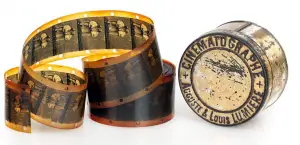
To accommodate the demand for celluloid, around 1908 at least two different companies named Sakai Celluloid Co., Ltd and Japan Celluloid Artificial Co., Ltd were created in Japan. Over the course of the next several years, more and more companies entered the market with their own celluloid production. For the first few years of the 1910s, the celluloid market thrived. Interest in film during the beginning of the first World War continued to grow and the large Japanese celluloid industry was booming.
Around 1918, after the war had ended, demand for celluloid would quickly decrease, causing the entire Japanese market to fall into turmoil. In an effort to survive, many of the leaders of the various celluloid businesses would all agree to join forces and create a single entity in the market to better survive. In September 1919, with a capital of 12.5 million yen, the Dai-Nippon Celluloid Company would be founded as a unified producer in the Japanese celluloid industry.
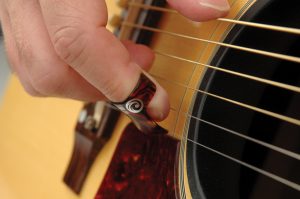
The plan worked, and in the 1920s, Dai-Nippon would become one of the world leaders in celluloid production. Although most commonly used in cinema film, celluloid had uses in other products such as jewelry, buttons, dolls, fountain pens, musical instruments, and knife handles. The company’s profits soared, and by 1934, there was a need to separate the film business from the rest of the company, so as a result the Fuji Photo Film Co., Ltd was formed in January 1934 to concentrate solely on celluloid production for the film industry.
Over the next decade, Fuji would produce all varieties of cinema and still film, along with other types like that used in X-rays and other scientific equipment. Their goal was to be the premiere Japanese film maker and compete internationally with the likes of Kodak and AGFA.
In the early 1940s, Fuji would expand their operations and begin making optical products solely for the Japanese military. In my research for this article, I could find very little information about what types of products these were, but most likely they were lenses for scopes, binoculars, and other war-time products.
After the war, it seems that the Fuji company would reorganize into several smaller divisions, all managed under the same corporate umbrella, but what little I could find on it was hard to follow. As best as I can tell, these separate Fuji companies would all fall into a single entity known as the Fujifilm Group.
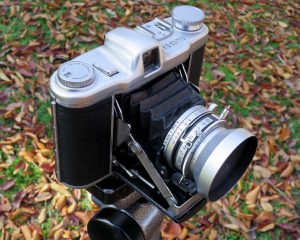
In 1948, Fuji would release it’s first camera, a medium format folding camera called the Fujica Six which would shoot 6cm x 6cm images on 120 roll film. Fuji likely followed the trend of combining it’s own name with ‘camera’ to come up with Fujica, just like Leica, Konica, and Nicca had done.
The Fujica Six would most closely resemble other German 6×6 medium format folding cameras like the Zeiss-Ikon Nettar and the AGFA Isolette. It was a pretty successful model, spawning several variants and staying in production until at least 1953.
During the 1950s, Fuji would experiment with several other film cameras like the Super Fujica Six, and the Fujicaflex TLR, but their focus was still on photographic film.
In the late 1950s, Fuji would finally get into the mid range 35mm market. All of Fuji’s new models had some distinctive feature like a rangefinder or automatic exposure that kept them a step above the typical entry level 35mm camera. Fuji was no stranger to making quality products, so even though they faced stiff competition from many other Japanese 35mm makers, their products usually fared well when put in a head to head comparison with a competing model. Models like the Fujica 35-ML, Automagic, and Fujicarex SLR were all well built cameras with excellent lenses, quality exposure meters, and good designs.
Around 1959, the Olympus Optical Co., Ltd. sparked a revival of “half-format” 35mm film with the release of the Olympus Pen, in which the camera would only expose half of a typical 24mm x 36mm image. Since each image uses exactly half of the space on a roll of film, you get double the number of exposures. The Olympus Pen was a huge hit, especially in Japan, and as a result pretty much every other maker rushed their own half-frame designs to the market.
Fuji was no different, and in 1963, would release their own half frame camera, simply called the Fujica Half. Despite it’s small size, the Fujica Half packed in quite a few features including shutter priority automatic exposure with full manual override and an excellent 5-element Fujinon f/2.8 lens. The Fujica Half had a couple of variants, a Fuji Half 1.9 with upgraded f/1.9 lens, a Fujica Rapid which used AGFA Rapid cassettes instead of traditional “Kodak” 35mm cassettes, and the Fujica Drive.
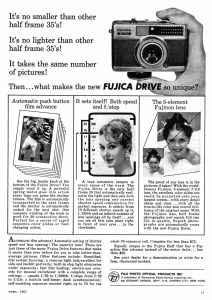
The Fujica Drive was nearly identical to the original Fujica Half, but with one big difference. Grafted onto the bottom of the camera was a large black wheel which was connected to a spring loaded motorized film advance which when wound fully, could set and fire the shutter automatically after each press of the shutter release. If desired, a photographer could capture 20 exposures in 20 seconds with this new system. These kind of clockwork motorized film advances were a fad around this time, with competing models from Kodak, Robot, and even the Soviet company GOMZ making their own clockwork motorized cameras.
The Fujica Drive carried a $15 premium over the regular camera, and sold for “less than” $75, which when adjusted for inflation is like $600 today. I can’t say with any certainty how popular this camera was as they don’t seem to come up for sale much. In my research for this article, I found the advertisement to the right from April 1965, but very little other information about it.
Throughout the rest of the 1960s and into the 70s, Fuji would continue to release new camera models, but it seems as though their camera business was a bit of an afterthought as they maintained a “film first” company, much like Eastman Kodak. Fujica SLRs of the 70s and 80s seemed to have limited success, but what little I could find about cameras like the Drive seem to be few and far between. Everything I’ve read seems to be positive, but I find it strange that a successful company like Fuji did not achieve greater success making cameras.
Today, there’s little demand for the Fujica Drive which is a shame as it’s an interesting piece of camera design. It is the only half-frame 35mm camera that came with a motorized film advance, auto exposure, and an excellent 5-element f/2.8 lens. Even if there was one other camera like this, it likely is rare too. There probably aren’t many people out there who specifically collect Fujica camera, but if you like well built mechanical cameras from the 1960s, you could do a lot worse than this one!
My Thoughts
The best cameras to shoot and review are the ones that are fun and offer something in the way of uniqueness that you can’t get with other models. With so many different models made by so many different companies over the course of more than 100 years, there are quite a bit of similar models that don’t stand out among the crowd, but some still do.
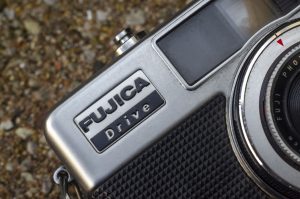
One of those cameras is the Fujica Drive, a relatively unknown model that I only learned of when I saw it in a job lot of cameras being sold. The Drive is a variant of the Fujica Half, upgraded with a mechanical wind-up motorized film advance much like how the Kodak Motormatic 35 is a variant to the Kodak Automatic 35.
Unlike the Motormatic, or any other clockwork motorized cameras in my collection, the Fujica Drive is also a half frame camera, which puts it into a very small number of cameras made with both features. There were many motorized cameras, and many half frame cameras, but not many with both.
My only other experience with a non SLR Fujica camera was the excellent Fujica 35-ML which I reviewed here. I remarked that the 35-ML was a well built and sturdy camera with a few interesting design choices, and an excellent lens. The images that it produced rivaled some of the best 35mm negatives I’ve seen from any camera. When I discovered that the Fujica Drive was made by the same company, but with a half frame design, motorized film transport, and a similar 5-element f/2.8 lens, I was intrigued.
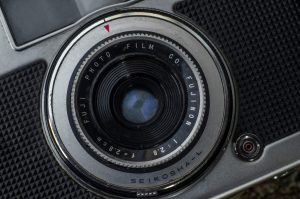
Thankfully, when the camera arrived, it was in excellent mechanical and cosmetic condition. I did get some movement out of the exposure meter, but it did not appear to be consistent, so I figured that I wouldn’t rely on it when shooting. Thankfully, despite being released during the peak of the “fully automatic electric eye” craze of the very late 1950s and early 60s, the Fujica Drive can still be shot in full manual mode.
The Drive is both compact and solid feeling. It has a weight of 514 grams and feels very sturdy. The body doesn’t creak in your hands, the wind knob has right amount of tension where you can have confidence that it still works correctly, and all of the critical controls move firmly, without feeling tight.
The body covering is unlike any I’ve seen on another camera. It’s basically a bunch of tiny little pyramids in a repeating square pattern. It’s not particularly grippy like leather would be, but there’s enough texture to allow for a secure grip. The body covering on my example is not cracked or peeling anywhere on the camera, suggesting the adhesive that was used was of high quality.
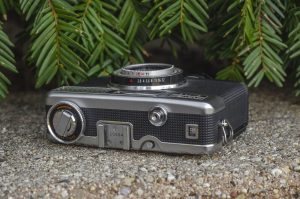
The top of the camera has a strip of the body covering from the back running down the center to give it a nice textured feel that you don’t normally see on the tops of cameras.
Starting on the right is the automatic resetting exposure counter, shutter release, rewind release button, and an accessory shoe.
On the left is the rewind lever surrounded by the self-timer dial. The self timer on this camera is a bit different from other cameras in that the shutter release is not used to fire the shutter when the self timer is set. Instead, the Drive has an activation slider on the back of the camera that is used to “Lock” and “Start” the self timer. To set it, first, move the slider to the “L” position and turn the self timer ring as far as you need. A full turn of the self timer is 10 seconds, but you can partially turn it for a shorter delay. With the self timer set, when you are ready to start the countdown, simply move the slider to the “S” position and you’ll hear the ticking of the timer counting down. Upon reaching the end of the countdown, the shutter will fire, all without ever touching the regular shutter release. I have no idea why Fuji designed the camera this way as opposed to others in which the self timer starts upon pressing the shutter release. I don’t think it has anything to do with the motorized film transport, as the non-motorized Fujica Half has a self timer that works the same way.
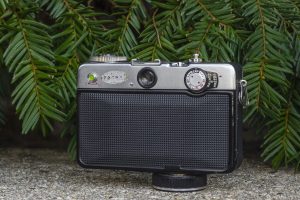
The back of the camera has the previously mentioned “S/L” switch for the self timer, the viewfinder eyepiece and a film speed ASA dial for the meter. The film door has the same textured pattern as the rest of the camera.

Loading film into the camera requires releasing the lock on the camera’s left side. Other than the half frame film gate, the compartment resembles most other 35mm cameras of the day. Film transports from left to right with a fixed take up spool on the right.
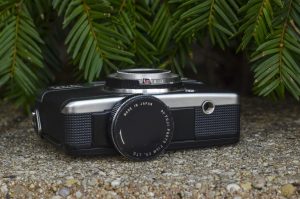
On the bottom is both the tripod socket and the large dial for winding the camera’s “Drive” system. This is one area in which the Drive shows that it wasn’t originally designed to be a motorized camera. The large knob somewhat resembles a small Oreo cookie and looks grafted on. Although not centrally located, the camera can still balance on the dial when placed on a flat surface. Winding the camera up isn’t hard and the knob accomplishes it’s intended purpose fine, but this is the worst implementation of the 4 wind-up cameras in my collection. The Berning Robot and GOMZ Leningrad each have their knobs on the top of the camera, and the Kodak Motormatic has the knob on the bottom, near the edge, but is balanced out by similar sized “foot” on the other side giving a sense of symmetry. While shooting with the Drive, I struggled on more than one occasion to get the camera in and out of my coat pocket as it often snagged on the large wheel.
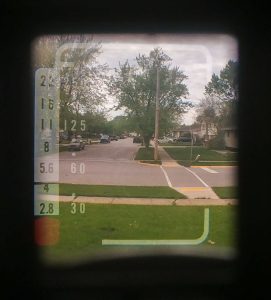
The viewfinder of the Fujica Drive is appropriately small for a half-frame camera, but still large enough to see important details through while wearing prescription glasses. This is a scale focus camera, so there is no rangefinder or any other kind of focus aide in the viewfinder.
Thankfully, the 2.8cm lens has a wide depth of field that is optimized for portraits and group shots. Each mark of the focus ring has a “click-stop” which you can feel with the camera to your eye giving you tactile feedback to what focus distance the camera is set at.
According to page 20 of the Fujica Drive’s user manual, when shooting in good lighting, with the iris set to f/8 and the focus set to the “G” setting, everything from 5.6 feet to infinity will be in focus which effectively makes this a focus free camera outdoors for everything except closeups. If you want to shoot a closeup, set the lens to the “P” setting, stop down the lens to f/16 and everything from 1.9 feet to 5.0 feet will be in focus.
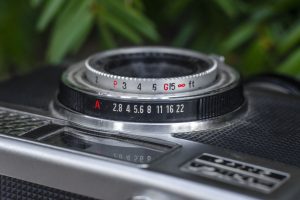
The namesake of this camera is “Drive” which refers to the motorized film transport, but in my opinion, the best part of this camera is that it offers both full program Auto Exposure, but also full manual control. With the advent of “electric eye” automatic cameras, the availability of manual control started to disappear from many compact cameras. That’s not true with the Fujica Drive as you can have both. In addition, many AE cameras that do offer manual control, disable the meter when switched to manual mode, which isn’t the case here. The meter needle in the viewfinder will still register a recommended setting, even in manual mode that you can choose to set or not.
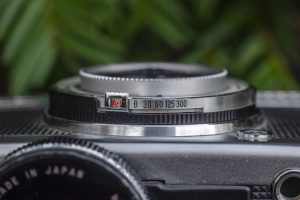
To use the camera in manual mode, simply turn the black ring around the shutter away from the red “A” mark to one of the seven f/stops to set the aperture, and flip the camera over and move the shutter speed selector away from the “A” mark to one of the 4 shutter speeds or Bulb. You must remember to also set a shutter speed when shooting the camera manually as it will default to the flash sync speed of 1/30 if you do not. Conveniently, when putting the camera back into Auto mode by turning the red dial back to “A”, the shutter speed lever will automatically move back to it’s red “A” also, so there is no chance you could set camera to Auto mode and leave the shutter speed selector at one of the manual speeds.
This certainly isn’t the most convenient of setups with the f/stops and shutter speeds on opposite ends of the shutter, but it’s forgivable in the interest of making the camera as compact as possible. Plus, I doubt many people who would have bought this, or the similar Fujica Half would have ever used the manual modes. Of course this is very useful today if you find a camera with a dead meter.
It seems obvious that the Fujica Half that this camera was based on was a really well thought out and high quality camera. The designers at Fuji clearly had a goal of making a compact camera as good as they could make it. The addition of the motorized film advance is certainly neat, and keeps with the popularity of this feature at the time, but feels like an afterthought to me. The neatness of hearing the motor wind after each press of the shutter release wears off quickly and frankly, I don’t think I’d ever need to fire off 20 shots in 20 seconds as the marketing for this camera suggests.
My Results
In the past when shooting half frame cameras, I’ve chosen 12-exposure rolls of film to get 24-exposures since any more would take longer to shoot. Having a sneaking suspicion that I was going to like this camera more than just another half frame 35mm camera, I went with a fresh 24-exposure roll of Fuji 200. I’d need to fire off 48 shots before I could see my results, but that’s ok. After all, the motorized film advance should come in handy, right?
Half frame cameras are interesting things. What seems like a pretty simple concept of taking a full frame camera and cutting the film gate in half to give you half the image size and therefore twice as many pictures, brings forth a number of challenges.
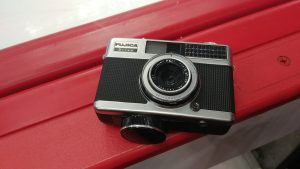
For one, with half the image size, you have what we call today a “crop factor”. With a 50mm lens attached to a full frame camera, if you halve the image size, you end up with a nearly 100mm view. As a result, half frame cameras need to have what would normally be considered wide angle lenses to get the same “normal” field of view.
In addition, since you have less area for the exposed image, if you were to enlarge the resulting image to the same 4×6, 5×7, or 8×10 image size as a full frame camera, any anomaly in the image like grain or imperfect focus is more noticeable. To counteract the perceived loss of detail in a half frame image, manufacturers were required to increase the sharpness and quality of their lenses.
Manufacturers like Fuji and Olympus had to get out their best 5 and 6 element lenses for cameras like the Drive and the Pen series in order to maintain a quality image. This obviously increases the cost to manufacture the camera. If the cost is higher, then who is the target customer? It’s gotta be someone who appreciates the economy of getting 48 exposures out of a roll of 24, but is still willing to pay for a premium camera with a sharp 5-element lens.
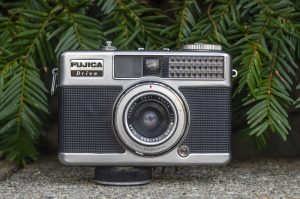
Thankfully, this is a question that we don’t need to answer today. With a large supply of cheap used half frame cameras like the Fujica Drive out there, we can afford to pick up one of these gems and appreciate the quality that went into them. The 5-element Fujinon lens here is quite spectacular indeed. It’s 2.8cm or 28mm focal length is still a bit narrower than a 50mm lens on a full frame camera and it shows. I found a few instances, especially indoors, where I wanted the camera to be a tad wider. I think an 18mm or 20mm lens would have been perfect.
Still, this is but a small nitpick as the images I got from this camera were outstanding. I scan all of my images on my Epson V550 scanner at 3200 dpi and then resize them to no wider or taller than 3000 pixels for these reviews. Looking at these sample images at 3000 pixels wide, compared to 3000 pixel wide images shot on a full frame camera, I can hardly tell a difference. The sharpness and detail is nearly identical to that of a full frame camera and lens. What little difference in detail I notice doesn’t seem like its the result of half the image area.
Half frame cameras were far more popular in Japan during the 1960s, and with only a few exceptions, didn’t continue into the 70s and 80s, but with models like the Fujica Drive, it certainly wasn’t due to the quality of images. I was so impressed with the Fujica Drive, that I almost wish it was full frame, just to see what kinds of images this sharp lens could have given us with more surface area!
If all you care about is the design of the camera, the compact size, and the excellent Fujinon lens, then you can get the same exact results from the Fujica Half. Although I generally like wind up mechanical cameras like this, the implementation of the wind knob seems like an afterthought and decreases portability. The camera got stuck more than once while trying to be pulled out of my coat pocket. I still think it is a neat camera, but in this case, I think the Fujica Half might be the better of the two.
Related Posts You Might Enjoy
External Links
http://camerapedia.wikia.com/wiki/Fujica_Drive
https://cameragocamera.com/2017/02/15/fujica-drive/
http://www.rolandandcaroline.co.uk/fdrive.html
https://www.lomography.com/magazine/281357-lomopedia-fujica-drive
https://www.photo.net/discuss/threads/fujis-wind-up-wonder.466564/
http://picturenoise.blogspot.com/2012/03/fujica-drive-half-frame-camera.html

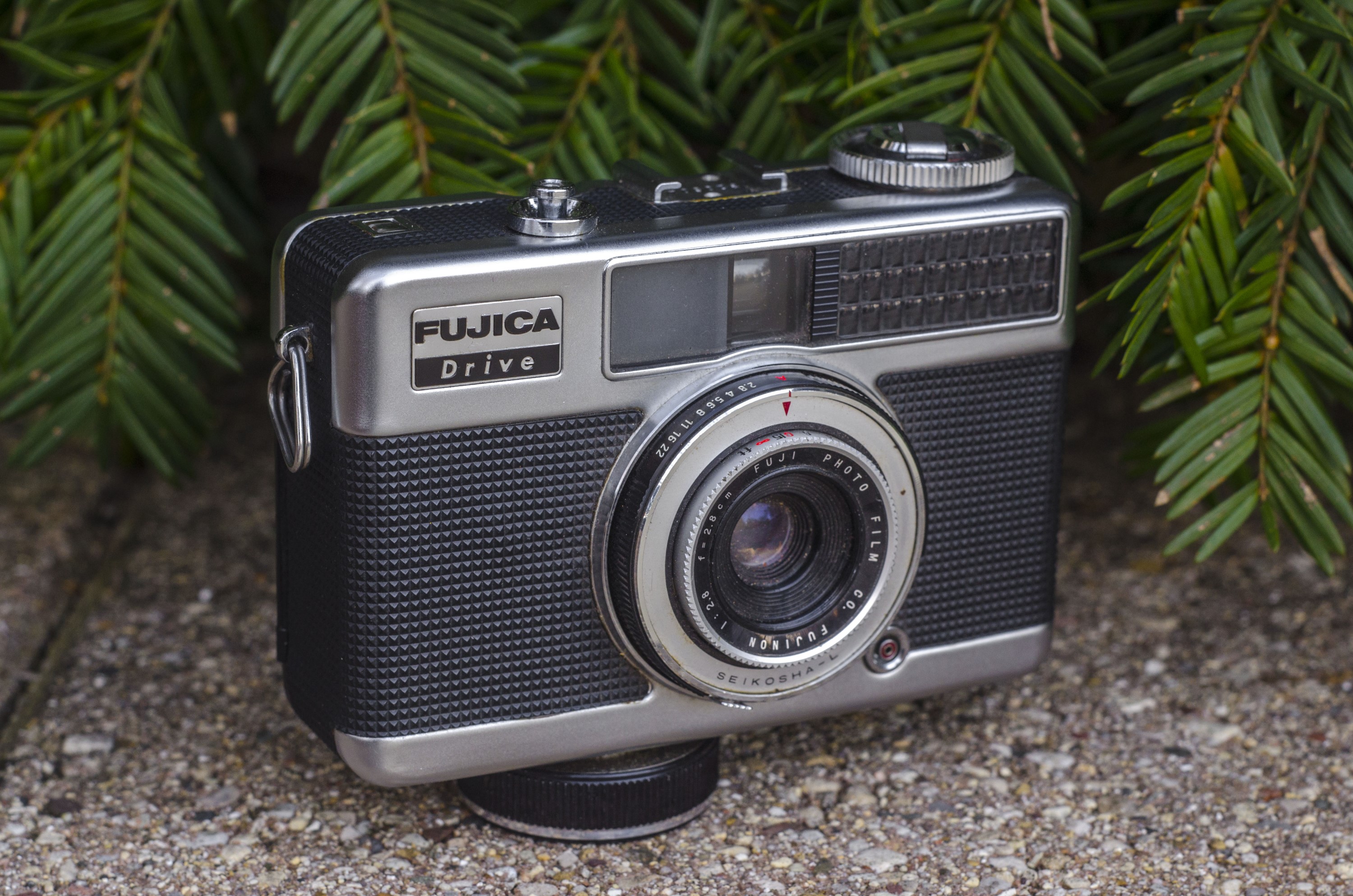
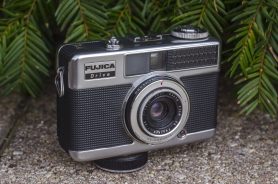









The “pyramid grip” looks similar to the original Yashica Electro-35’s grip. Do you have one of those to compare?
I do have a couple original “non-G” Yashica Electros in a box somewhere. I’ll have to dig one out and compare it.
I got one yesterday, cleaned it and got 73 shots out of a 36 roll.
Awesome results in my opinion. I enjoyed it very much.
I have a problem though, which is that despite the lenses are immaculate after some magic, I can’t find the way to get to the viewfinder to clean it, since it needs care and love, and a lot of cleaning. There is a lot of dust that makes the image foggy.
All the rest of the camera works perfectly.
I’ll upload some photos to my fb Roman D. Sanz shortly.
I will be very happy to get some advice from you.
Roman
Just got one of these and put my 1st roll through it as well today. It was a blast! Great looking camera and the motor drive feature was tons of fun and worked well. Meter seems accurate. Hard to believe there’s no batteries in this very functional little gem. Negs are drying now, but they look good so far. Great little camera. Great review! On a side note about synthetic leather coatings from the 60s… I think Mamiya tops them all with the skin on my C22. It’s tiny raised ‘M’s in place of the pyramids found on the Fujica Drive. Very neat, very grippy, and probably a bit costly at the time.
I agree with everything you said. I already have a fondness for clockwork motorized cameras like this, but throw in an awesome lens, and a very compact and fully automatic form factor, that’s a formula for success. If you like the Drive a lot, a full frame camera that’s very similar which I recommend you check out is the Ricoh Hi-Color 35. Check out my review:
https://mikeeckman.com/2020/05/ricoh-hi-color-35-1968/